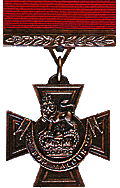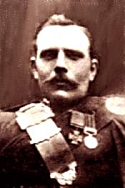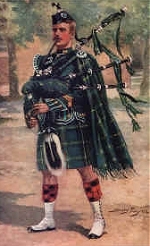
 PIPER
GEORGE FINDLATER, VC
PIPER
GEORGE FINDLATER, VCThe Gordon Highlanders

 PIPER
GEORGE FINDLATER, VC
PIPER
GEORGE FINDLATER, VC
The Gordon Highlanders
Born George Frederick Findlater on 16 February 1872, his parents were Alexander Findlater and Mary Ann Clark. His father was a journeyman miller working on a farm, sometime of the Mill of Turriff. His grandparents were John Findlater and Sophia Porter, of the Mill of Auchinbadie. He wanted to be a soldier but his parents strongly objected.However, in April 1888, after a couple of years of farm work, George Findlater enlisted in the 2nd Battalion Gordon Highlanders, in Aberdeen. At the famous charge by the Gordon Highlanders up the heights at Malakand, on 3 April 1895, he had a narrow escape when a bullet carried away the heel of one of his boots. In the subsequent encounters he is said to have acquitted himself nobly, and fortunately received no serious wound.
From childhood George Findlater had shown a taste for music and, shortly after
enlistment, he began the study of the bagpipes. At the beginning of 1896 he
was promoted to the rank of piper in the band of the regiment. In the summer
of 1897 tribesmen of the North-western frontier of India (now a part of Pakistan)
began attacking and intimidating British forces in the area. The Indian Government
decided that the unprovoked attacks by the Afridis and the Orakzais tribesmen
could not go unpunished and decided that a show of force in Tirah, the tribe’s
summer home, was appropriate. Accordingly, Sir William Lockhart was ordered
out from Britain and appointed to command a force of 32,882 officers and soldiers.
The intention was to advance into the Chagru valley on 20 October but the Alikhel
tribesmen had seen the preparation of a mountain road by the army working parties.
They anticipated the route to be taken by the army and occupied the village of Dargai and the Narik spur. This formed the western boundary of the valley and completely dominated the road along which the Expeditionary Force was to descend. It was therefore necessary to dislodge the tribesmen from their position. The water supply of Dargai was some distance away from the village and General Palmer saw that adjacent heights would have to be taken if it were to be reached. The tribesmen were not expected back and the order to retire was given. Two companies of the Gordon Highlanders were left to hold the tribesmen in check till the other regiments had taken up a new position. First one company was ordered to retire and then the other. Only half of the last company remained when the enemy appeared behind them from over a hill only thirty yards away. The Gordon Highlanders promptly formed up as the enemy fired and rushed them thinking them defeated. The men stood their ground and killed six of the tribesmen only yards from them. The other tribesmen turned and ran.
General Kempster’s brigade was ordered to storm the Heights and the 1st Division was strengthened by the 2nd Derbyshires and the 3rd Sikhs. They were to be supported by three batteries with another on Samana Sukh if required. The Gurkhas, Dorsets and Derbys all suffered terrible casualties and were met by such intense fire, from only 200 yards away, that those who were not cut down in the charge could do no more than hold onto the position they had reached. Over 100 men lay dead and wounded. The tribesmen rejoiced, waving their standards and beating their drums as victory seemed assured. General Kempster ordered the Gordon Highlanders to the front. The Gordon Highlanders advanced. The dead and wounded of the other regiments were brought back. On getting to the spot reached by the Derbys and Dorsets, the Gordons lay under cover for three minutes as the guns again concentrated their fire on the summit.
The moment came to advance. The Pipe-Major of the Gordon Highlanders was superintending the bringing up of the reserve ammunition when the order to advance came through and he was still doing so when the order to charge was given. Lance-Corporal Piper Milne was the next most senior piper and he led Pipers Findlater, Fraser, Wills, and Kidd into action. In his despatch to the Adjutant-General in India on 9 December 1897, Sir William Lockhart recalled that, "The Gordon Highlanders went straight up the hill without check or hesitation. Headed by their pipers, and led by Lieut-Colonel Mathias, CB, with Major Macbean on his right and Lieutenant A F Gordon on his left, this splendid battalion marched across the open. It dashed through a murderous fire…" As the Gordon Highlanders burst into the field of fire Major Macbean fell almost immediately, shot through the thigh. He dragged himself to the shelter of a boulder and cheered on his men as they passed. A bullet hit Piper Milne in the chest and he fell, unable to continue. Three-quarters of the way across the exposed strip of land Piper Findlater was shot in the ankles. He fell and, leaning against a rock, continued to play his pipes as blood ran from his wounds, dying his kilt red. Of the five pipers who led the charge only Piper Kidd made it to the Heights.
The first division reached the sheltering rocks and paused for breath. As their numbers increased to 400 they started again up the precipitous path to the crest of the hill. Reaching the top they rushed along the succession of ridges as the tribesmen took flight. The position was won at 3.15pm. The Gordon Highlanders gave three cheers for Colonel Mathias. As he came over the last ascent the Colonel had rather breathlessly commented to a colour-sergeant, "Stiff climb, eh, Mackie? Not quite - so young - as I was - you know." With a friendly slap on his commanding officer’s back the sergeant replied, "Never mind, sir! Ye’re ga’un vara strong for an auld man!" Major-General Yeatman-Biggs reported favourably on several Gordon Highlanders. "Major F Macbean, who was the first to spring out of cover and lead his company to the attack... Piper Findlater, who after being shot through both feet and unable to stand, sat up under heavy fire playing the regimental march to encourage the charge... Private Lawson, who carried Lieutenant Dingwall, when wounded and unable to move, out of a heavy fire, and subsequently returned and brought in Private Macmillan, being himself wounded in two places in so doing... I recommend Piper Findlater and Private Lawson for the Victoria Cross."
Later, Findlater wrote, "I remember the Colonel addressing the regiment, telling them what they were expected to do. I remember again the order for the regiment to attack, and the order "Pipers to the front". I am told that the ‘Cock of the North’ was the tune ordered to be played, but I didn’t hear the order, and using my own judgement I thought that the charge would be better led by a quick strathspey, so I struck up ‘The Haughs o’ Cromdale’. The ‘Cock o’ the North’ is more of a march tune and the effort we had to make was a rush and a charge. The battle fever had taken hold of us and we thought not of what the other was feeling. Our whole interest being centred in self. Social positions were not thought of, and officers and men went forward with eagerness shoulder to shoulder. When I got wounded the feeling was as if I had been struck heavily with a stick. I remember falling and playing on for a short time; but I was bleeding profusely and in a few minutes sickened. I am told that the time I continued playing after falling was about five minutes. After the position was won, and the wounded taken to the rear, my first thoughts on recovery were how lucky I had been in getting off so easily. It never occurred to me that I had done anything to merit reward. What I did I could not help doing. It was a very great surprise when I was told that my action had been brave, and a recommendation had been made to award me the soldier’s prize - the VC."
George Findlater was invalided home
and offered a position, probably at Balmoral. He declined this because of the
poor pay.  He
then took up a concert career for some time, much to the distress of the War
Office. Returning from his travels Piper Findlater settled at Mountblairy in
the parish of Alvah, Banffshire. Both of his parents were dead but he was not
far from many of his family who lived in the surrounding countryside. On Wednesday,
2 August 1899 George Findlater married his cousin, Nellie Findlater. Nellie’s
late father, John, was the brother of George’s father. She was 23 years of age
and lived at South Brownside, Forglen. The wedding took place at St Congan’s
Episcopal Church near Mill of Turriff where Piper Findlater had been born. The
Revd George Lawson, minister at Forglen, performed the ceremony. Nellie Findlater’s
sister Jessie was bridesmaid and Piper Findlater’s brother James, from Birmingham,
was best man. When the Findlaters returned from their honeymoon they settled
in a newly-built cottage near the banks of the Deveron at Mountblairy. Piper
Findlater’s ambition had always been to find a small farm and by June 1900 he
had secured the tenancy of a holding at Bridgend, Forglen on the estate of Mr
Harvey of Carnousie. George and Nellie Findlater had four children at Bridgend.
John Alexander was born in 1900; Frances Harvey in October 1900; Mary Ann in
November 1901, and Frederick George in April 1904. The Findlaters moved to a
30-acre farm in Forglen, Cairnhill, and in September 1909 Helen Kennedy was
born there. George and Nellie were to live at Cairnhill for the rest of their
lives.
He
then took up a concert career for some time, much to the distress of the War
Office. Returning from his travels Piper Findlater settled at Mountblairy in
the parish of Alvah, Banffshire. Both of his parents were dead but he was not
far from many of his family who lived in the surrounding countryside. On Wednesday,
2 August 1899 George Findlater married his cousin, Nellie Findlater. Nellie’s
late father, John, was the brother of George’s father. She was 23 years of age
and lived at South Brownside, Forglen. The wedding took place at St Congan’s
Episcopal Church near Mill of Turriff where Piper Findlater had been born. The
Revd George Lawson, minister at Forglen, performed the ceremony. Nellie Findlater’s
sister Jessie was bridesmaid and Piper Findlater’s brother James, from Birmingham,
was best man. When the Findlaters returned from their honeymoon they settled
in a newly-built cottage near the banks of the Deveron at Mountblairy. Piper
Findlater’s ambition had always been to find a small farm and by June 1900 he
had secured the tenancy of a holding at Bridgend, Forglen on the estate of Mr
Harvey of Carnousie. George and Nellie Findlater had four children at Bridgend.
John Alexander was born in 1900; Frances Harvey in October 1900; Mary Ann in
November 1901, and Frederick George in April 1904. The Findlaters moved to a
30-acre farm in Forglen, Cairnhill, and in September 1909 Helen Kennedy was
born there. George and Nellie were to live at Cairnhill for the rest of their
lives.
When war broke out in 1914 George Findlater was a 42 year old farmer. The 9th Battalion of The Gordon Highlanders was formed at Aberdeen in September 1914. Findlater volunteered for service. In January 1915 the battalion was made a Pioneer battalion providing labouring jobs for low-grade medical men. He travelled to France with the battalion in July 1915 as a Sergeant Piper and was wounded at Loos. Invalided out of the army he returned to Aberdeenshire to his farm. He received the 1914-15 Star medal and the British War and Victory medals. For the next 27 years George Findlater farmed Cairnhill and was active in the Turriff pipe band as Pipe-Major.
On 4 March 1942 George Frederick Findlater, VC, the Piper of Dargai, died of a heart attack aged 70 years. His widow, Nellie Findlater, died on 15 December 1949, at Cairnhill, aged 74 years. George and Nellie Findlater are buried in Forglen cemetery a short distance from Turriff. The cemetery is hidden away at the bottom of a steep track on the left-hand side of the road to Forglen, just past the second farm on the left after passing over the bridge at Turriff. A tiny sign points down the track to "Kirkside". The Findlater gravestone is about three-quarters of the way along the east wall of the cemetery.
The full story is on www.geocities.com/Athens/Atlantis/2359/contents.html. I must offer thanks to the compiler of the story for the information in this brief note.